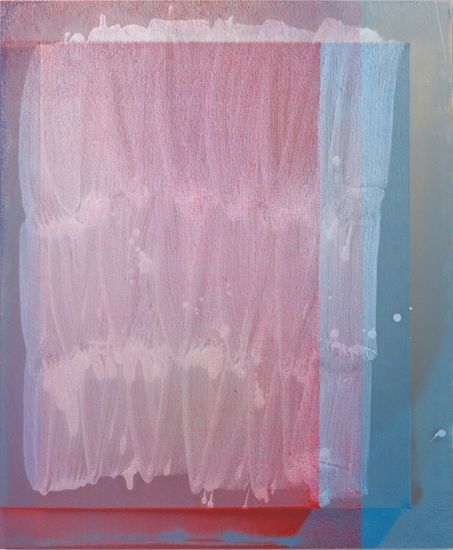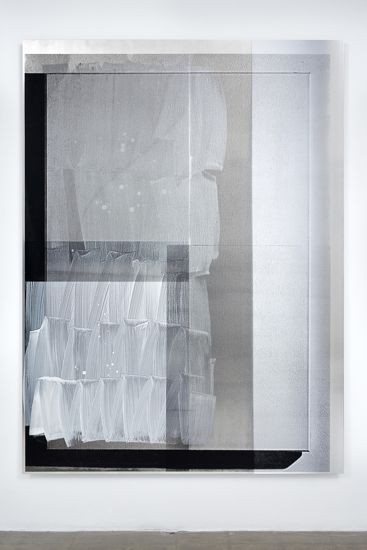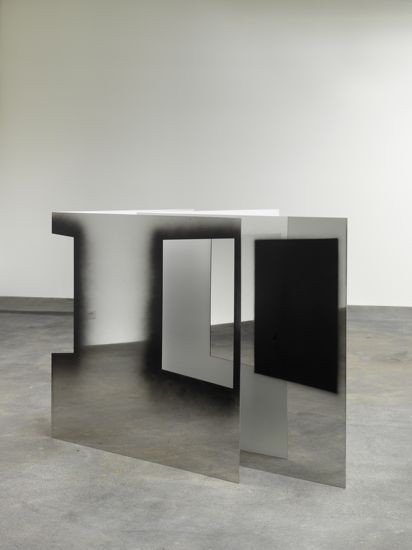II. Seeing in Pieces

Untitled (2010), acrylic, silkscreen on aluminium, 86.3 x 58.4 cm. Photo Kei Okano, courtesy
Nathan Hylden and Misako & Rosen.
ART iT: We were just discussing your use of stencils to contradict the presence of the painting as object. In this sense I’m also interested in your use of the surface of the paintings, or your approach to superficiality, especially with the works using metal sheets where in parts you can see through paint to the reflective surface beneath it. In a sense this effect pushes the gaze away from the surface rather than absorbing it into the surface, as one would expect with a conventional painting.
NH: Yes, you see all the way through them, so it plays with depth, but it’s also about the physical relationship, so you’re reflected in it and you both see the image and yet see through the image at the same time. In certain ways the paintings do have a sense of deflection. They have these plays on depth that aren’t necessarily absorptive, but maybe it’s more like they become an ether or something.
ART iT: It’s almost like I don’t know where to stand.
NH: That’s a good way of putting it, because you see the reflections through them and with the metallic paints they change with every position. They don’t really have one focal point of entry, and that connects with the idea of dispersal in the use of stencils in the works, so that each work is never the one, and you have to continue from one to the next to the next.
ART iT: Have you ever installed the paintings side to side?
NH: I’ve thought of that but never done it in an exhibition. I’ve seen it in my studio. It has a really nice effect because there’s this positive and negative play between each work, so there’s a strange optical effect of what’s present. There’s an area that’s inside and outside at the same time.
That’s something I’ve been interested in as well: the idea of the frame. If the conditions around the work are what make the work, then the frame is implicated in what’s inside the work, but it also sits on the outside so it has this double-condition of being both inside and outside of the work at the same time.
ART iT: Previously you’ve mentioned Heidegger as a reference. Are there any other philosophers who inform your practice?
NH: One idea that I was thinking of with all the works with the images of the canvas is from Gilles Deleuze’s The Logic of Sensation (1981), about Francis Bacon. Deleuze says that the blank canvas is not blank at all but is full of every painting that’s ever been painted. Even the most basic convention of painting – the rectangular white form – is always already full of history. I enjoy the thought that simple conventions are already full of a multitude of ideas.


Top: Untitled (2009), acrylic on aluminum, 196.85 x 144.78 cm. Courtesy Richard
Telles Fine Art, Los Angeles, and Misako & Rosen, Tokyo. Bottom: Untitled (2010),
lacquer on stainless steel, two parts, each 147 x 98 x 147 x 128 cm. Courtesy Johann
König, Berlin, and Misako & Rosen, Tokyo.
ART iT: You discuss your works in terms of form, but would you go so far as to describe what you’re doing as a kind of formalism?
NH: I have to say it’s not formalist. There’s an important distinction because of all the play with the index, not to mention the use of imagery. All of the works in this exhibition are image-based, using a photograph of a canvas. They’re definitely playing with abstraction, but abstraction generally implies creating an ambiguity, versus formalist detachment. There are also certain dictates in the process of how I work that remove it from a formalist approach. To me formalism is maybe even impossible because ideally it should imply autonomy or no referent. A phenomenological reading of an artwork or consideration of an installation is already outside of this. It also implies an additive working method that is simply subjective or based on arbitrary academic rules of harmony and balance or dynamics, on to basic composition. I always begin with procedural dictates, however loose, and then whatever is the result of those steps becomes the work.
ART iT: Are you also removing your hand, so to speak?
NH: I think so, in that the process is in some sense a way out of making the decision. But I think the hand comes back in another way because the screen-printing itself has a bodily aspect. The stencil becomes the gestural device. But certainly there are no compositional decisions in the way that you would expect from formalism. For example, I might start with the simple idea of putting the stencil in one corner of the canvas and then repeating it until it gets to the other edge. It’s just about following a procedure and seeing where it goes. The results that you see in the paintings are not what I would have anticipated or would have had any idea about until after I see them myself. It’s interesting for me because I become another viewer in that sense.
Coming Soon:
Pt III. Difference is Difference
Nathan Hylden: Process Present Tense
